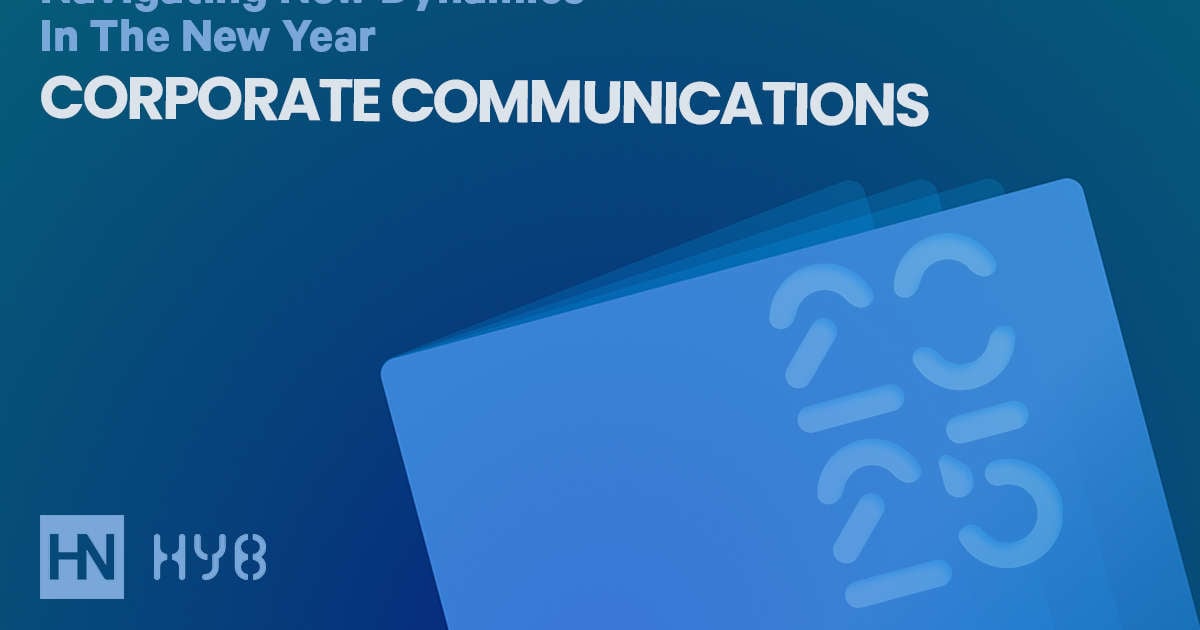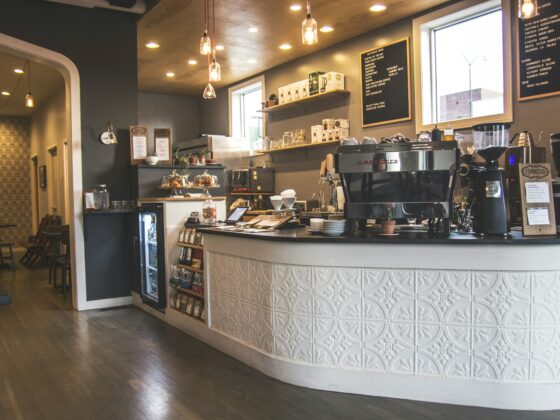
“In a rapidly evolving landscape…” – This Chat-GPT siren seems to be the most frequently used phrase of the past year and immediately makes me question the content that follows. However, we can all reluctantly relate to the statement and the Communications function is no exception. While the AI wave has flooded our daily lives, changing how we work and what we communicate, other societal trends and consumer behaviors continue to prompt (pun intended) fundamental changes within corporate communications.
As EHL’s Chief Corporate Communications Officer with touchpoints in education, hospitality, and innovation networks, I have a front-row seat to the transformation reshaping how we connect with audiences. If the communications landscape is indeed evolving rapidly, I’d argue that it’s been the case since the emergence of the social media. Advances in technology, changes in audience behavior, and an increased need for authenticity have been on the mind of communicators over the past decade at least. What’s changing in 2025 is that Corporate Communications is at a crossroads, where the integration of both digital innovations and human-centric strategies is no longer optional – it’s essential. From leveraging AI responsibly and creating hyper-relevant content to balancing speed with quality and rekindling the power of storytelling, understanding and adapting to these conditions are the key to future-proofing your communications strategy.
Digital Trends
More Content, More Channels but One Cohesive Experience
Communications have relentlessly shifted towards digital-first and never stopped. This trend will only strengthen in 2025, but the multiplication of digital channels is also heavily increasing the scale of content production and require a multidisciplinary approach more than ever. While tone, style and user expectations vary per channel, these can no longer be treated in silos. Users navigate between platforms, following multiple brand conversations at a time, and expect a form of consistency across the different channels to reinforce credibility.
Our audiences now expect a seamless integration across all digital touchpoints —whether that’s from blogs and social media to websites, email, chatbots and beyond. Additionally, with a majority of internet users expected to access the web solely via mobile devices, businesses must align their messaging across platforms and cater to this reality with the appropriate formats and content. This is leading to a blurring of traditional roles between PR, social media management, and digital marketing, entailing more cross-functional collaboration to ensure consistent and timely messaging.
The demand for short-form video is exploding, highlighting the need for more agility in our productions. According to HubSpot, in 2024, 89% of consumers expressed a desire for more video content from brands. With 75% of viewers watching short-form videos on their mobile devices, it’s no surprise that videos under 60 seconds are thriving, as people are more likely to share video content compared to other formats.
While users navigate across platforms, the platforms themselves are working hard to maintain audiences captive – and organic algorithms will penalize brands who take users outside of the ecosystem. Social platforms are integrating the full suite of digital touchpoints within their ecosystem, forcing brands to duplicate content within the channel to remain optimized and relevant. Similar to the digital landscape in Asia, we are moving toward more in-channel content, incorporating your web, social, chat, reels, videos, as well as payment checkouts, all wrapped into the same ecosystem.
All of this means a drastic increase in production of content going forward, tailored to each platform and incorporating more steps of the consumer journey directly within each platform.
AI: Friend and Foe–It’s Complicated
The integration of AI into content production is unlocking unprecedented efficiencies and addressing the growing demand for personalized, high-volume output. Yet, this bright promise comes with critical ethical and regulatory considerations. Recent controversies, such as the backlash against Coca-Cola’s AI-generated holiday ad – breaking away from its cherished traditional approach – highlight the risks of misaligned creative strategies, the growing fears for creative professions and the wider implications of delegating our content to AI. While the long-term impact remains uncertain, one thing is clear: AI is reshaping the landscape of communication and marketing with uncharted consequences.
The potential of AI is immense, but its use requires a delicate balance. Brands must prioritize authenticity and individuality while avoiding the traps of echo chambers, hallucinations and biases—pitfalls that can harm reputation and trust. Many emerging AI tools are powerful and promising but demand responsible implementation, especially concerning issues like data privacy, ethical practices, and regulatory compliance.
Looking ahead to 2025, we see that AI literacy, skills development, and training are becoming essential for communications professionals to navigate their careers in this new context. Understanding AI mechanics—such as the optimization of content to rank in AI-driven search engines —is now critical for maintaining brand visibility and relevance. The rise of real-time data access for gen-AI tools and transparency of sources add another layer of complexity, underscoring the need for thoughtful, informed strategies.
AI is no magic wand. To harness its benefits while mitigating risks, businesses must adopt a cautious, thoughtful approach—aligning innovation with ethical and practical foresight. As I said: it’s complicated.
Better and Faster – Balancing the Need for Both Quality and Speed of Publication
Speed is the name of the game in 2025. With the news cycle moving faster than ever, communications teams need to publish more frequently to stay relevant. With the average lifespan of a tweet lasting under 18 minutes, brands must find ways to stay visible while ensuring alignment with their core messaging.
Quality cannot be the scapegoat of speed – not with the amount of content available to consumers and the increased competition for attention. Authentic communications may be less polished, but the quality of messaging, tone, style and delivery is expected to remain the same as for major corporate productions.
How then, do you concede with fast, qualitative and sustainable production? How can teams increase the amount of content, in different formats while being faster to publish without burning out all together?
One answer lies in a combined effort to become more intentional about content produced, and how it can be recycled, reedited and reoptimized, while also dedicating time to improving the efficiency of production and publication processes.
All this means empowering teams to bypass lengthy approval processes and create content that is agile, aiming for impact rather than consensus. I once spent 3 months approving a sound bite for a corporate video, going all the way up and across the internal ladders for commentary and opinions. This traditional hierarchy of approval and involvement is no longer feasible – during that same timespan we now push out dozens of similar videos. The point is that regularity and frequency of publications play just as much into the success of your publications as the quality output – all are necessary factors to successful campaigns.
Empowering teams, and often more junior team members, requires a much more precise and complete brand playbook, SOPs and monitoring:
Defining a strong framework with the freedom to work autonomously within the strategy. Issues can – and will – still happen, and we must focus on our agility to correct the course rather than linger on preventing any misstep. This requires a company culture that not only delegates responsibility to individuals but also provides them with the guidance and framework to ensure brand consistency, as well as an ethos which accepts mistakes and allows us to learn from them. The key lies in balancing volume with alignment—ensuring that even rapid content stays consistent with core messaging and tone of voice.
Individualization Through Data and AI
Personalization has been a growing trend, but in 2025, we’re moving more towards true individualization. Social and search algorithms continue to refine the content people actually see and we are quick to scroll over anything that is not of interest to us in the moment.
AI and data analytics now enable organizations to tailor their messaging down to the individual level, creating content that resonates more deeply. In fact, 73% of consumers expect better personalization as technology advances according to a recent salesforce report, as audiences’ expectations continue to become more demanding.
AI’s ability to contextualize content will soon allow for “hyper-relevant” interactions, where messaging and search results dynamically adjust based on real-time consumer context. For example, imagine a consumer searching for “best hiking gear” on a platform. Today, they might receive general recommendations for top-rated products. In the near future, AI will combine the individual’s historical search patterns, purchase behaviors, geolocation, and even weather data to curate a highly specific list, such as “lightweight jackets perfect for the Swiss Alps in winter for beginners”. Additionally, AI-driven systems might notice that this consumer typically prefers sustainable brands and prioritize eco-friendly options in the recommendations, even weaving in content like a brief note on the company’s environmental initiatives—all in real time.
This level of contextualization doesn’t just match content to search intent; it aligns content to the individual’s nuanced needs, preferences, and environment, creating a much deeper resonance and engagement.
The same can apply to media and brands content marketing efforts. Imagine reading an article about climate change on your favorite news app: Instead of generic expert quotes, the AI will tailor the content to you by pulling recent statements from local environmental scientists or policymakers in your region. It might also integrate perspectives from nearby activists or organizations working on local sustainability initiatives, making the global issue feel directly relevant to your community and daily life.
Accessing, organizing, analyzing and leveraging data available will be critical to creating impactful content and dedicating resources where they matter. Again, these fundamental changes will require teams to upskill in order to understand and leverage this new potential.
Human Trends
The Return of Physical Touchpoints To Complement the Digital Realm
While digital-first remains the primary engine of today’s communications growth, the demand for in-person experiences is resurging. Despite the broad reach of digital touchpoints, building in-person “human” relationships with our audiences, or our communication relays such as influencers and journalists, is seeing a return with more personalized events.
Companies are increasingly leveraging curated events—such as roundtables or press briefings—to foster deeper connections. Online events have found a new equilibrium post-pandemic, with a noticeable shift back to a stronger preference for in-person conferences. “The state of in-person B2B conferences” reports that 80% of event organizers identify in-person events as their most impactful marketing channel, signaling their enduring value in communication strategies.
Visible “real” touchpoints serve as a complement to digital content, such as printed long-form reports (or at least print-at-home options) paired with short-form videos online. More subtle touchpoints, including carefully designed merchandising and personalized, intimate event formats, reinforce the art of hospitality and relationship-building. Creating lasting relationships with consumers requires a personal and human touch, beyond the screens.
This is a core theme we have embraced at EHL: placing human interactions at the center of all experiences, fostering meaningful connections and exceptional service. Brands who are able to elevate their HX – the human experience of customers, staff and stakeholders – and embody the true essence of hospitality will stand apart in the years to come.
Values at the Forefront
Connecting with our audiences in a meaningful way implies a deep understanding of their motivations, values and expectations. Consumers, especially younger audiences, now have heightened expectations for authenticity in brand communication, perhaps as a pendulum swing from the excessive influencer culture a few years back that largely forewent honest and objective communication. They are quick to detect (and reject) anything that feels AI-generated or insincere. This also means brands are now expected to position themselves on important, and often divisive issues.
8 out of 10 millennials expect companies to take a stand on social issues and want to align with the values of brands, going as far as to boycott companies with whom they perceive conflicting values. With such a potential impact on the bottom line, standing for social values is no longer optional for brands.
In short, audiences today are moving away from representing a fanbase to being part of a brand community that reflects their own values. This deeper relationship with consumers means that brands can’t remain neutral— they need to align with the values of their community, which can also exclude certain audience segments. Brands need to carefully decide where it makes sense to take a stand, understanding their audience’s beliefs and maintaining a constant finger on the pulse to identify shifting debates and risks for divisive polarization and unwanted controversy.
While new data shows that the influence of social values-based brand loyalty is starting to tone down, shifting to cost sensitivities and a more selective expectation of political or societal stands depending on the product, this remains a critical and sensitive area that communication professionals will continue to deal with in 2025. The perception of insincere commitments or fabricated shallow values hold a lasting reputational risk.
Going forward we must develop a thorough understanding of our consumers and maintain a hypervigilance on social trends and world events. This will enable us to offer an authentic and credible positioning on core values while continuing to show concrete action in line with those beliefs. Communications experts must be clear on what their brand stands for, and how they support their commitments in a genuine, long-lasting way.
Employee Advocacy and Internal Community
The same yearn for shared values extends across younger generations in all brand relationships, including the relationship with their employer. For Gen Z, who will make up 27% of the global workforce by 2025, authenticity ranks as the top factor influencing loyalty, emphasizing the need to align corporate identity internally and externally.
Leveraging employee advocacy is also becoming a vital part of humanizing brand communications. Employee-shared content garners 8 times more engagement than brand-shared posts, proving its effectiveness in building trust and enhancing brand visibility. By empowering employees, partners or stakeholders to share their own stories and experiences, organizations can add a more credible and personal dimension to their messaging.
The role of internal communications is therefore moving from employee information to becoming a key driving force for internal change, defining company culture and engagement. Leveraging employee advocacy helps to foster a sense of community and authenticity that resonates with audiences, making the brand more relatable and trustworthy.
Communication trends evolve, but the core principle remains the same : there is always an audience at the receiving end of your messages. We are not just producing content for platforms and algorithms, but for real people that navigate through a dense jungle of content, shaped by their own unique context and experiences. The human aspect of your human experience strategy cannot be understated— corporate identities are not confined to a website, a wall, or meticulously crafted taglines. Your brand promise lives and breathes through every interaction with internal stakeholders, layering over time to (ideally) form a coherent and meaningful brand relationship.
This brings us to the heart of your brand: its sense of purpose, higher mission, and reason for existence. Articulating this purpose helps crystallize your narrative, align your communications, and foster deeper resonance with your internal ambassadors. Dedicate time and effort to reviewing these foundational elements—they’re worth it.
Back to the Roots – (Re)connect to Your Inner Storyteller
With the rise of visual formats and condensed, on-trend social content, brand messaging can easily get lost in the constant strive for entertainment and engagement goals. This slow deviation from key content themes and brand messages may support rapid social engagement scores, however the relationship with consumers will remain shallow and short-lived. Viral content can definitely be advantageous, but it often fails to achieve sustainable long term objectives and is a precarious success.
Brands who are able to lean into their storytelling abilities with valuable and entertaining content can maintain steady attraction while also reinforcing their key messages and benefiting from greater impact. Beyond engagement, building a relationship with audiences demands content that is not only informative or fun, but a rich mix of both.
Content may still be king, but the Story wears the crown. Meloney Brazzola, Chief Corporate Communications Officer
Creating compelling messaging in the form of storytelling creates relatable and sharable content that can resonate with your audiences while equally serving your reputational and business goals together. As we endeavor to create more content, in more formats, for more channels, creating content that will serve multiple KPIs and sustain long term growth makes a strong argument.
In 2025, storytelling will be taking back center-stage for brands to transform a dry corporate message into relatable content, illustrate their values and purpose, showcase customer experiences and highlight real-world impacts of their products and services.
This emotional resonance enhances audience engagement, further supporting brand advocacy, sharing and loyalty. When younger generations’ purchase behavior is mostly influenced by word of mouth and online reviews, peer engagement and advocacy can further enable organic growth. Think corporate messages and advertising rolled into one
Crisis Communications: The Nexus of All Trends
Crisis communications operate at the nexus of all these trends—digital and human alike —and at high speed, high intensity, and high stakes. In times of crisis, the need for rapid, consistent, and authentic communication becomes even more critical. The increase in publication speeds means teams must be ready to respond immediately, while digital-first strategies ensure these messages reach audiences wherever they are.
Meanwhile, the necessity for authenticity and human connection require that brands communicate openly and empathetically during crises. Successful crisis communications in this new context leverage all the tools at their disposal—digital integration, employee advocacy, and personalization—to navigate challenging situations and protect the brand’s reputation.
However, the ability to act swiftly when needed depends on the organization being highly prepared. This includes clearly defined protocols, processes, and scenario planning to ensure decision-making is both efficient and fact-based. By outlining these elements in advance, organizations can reduce hesitation, maintain alignment across teams, and deliver cohesive messaging that reflects the organization’s official stance and values, even under pressure.
Thought Leadership
Many companies recognize the value of thought leadership and are embracing it within their corporate communications strategy. According to SEMrush’s 2024 guide on the topic, 65% of businesses already focus on thought leadership and 30% more are planning to start. Though a wide-reaching initiative, thought leadership supports authority building as subject matter expert by sharing expertise, engaging with professionals in your field and driving the innovation and development of your sector.
This has been a positioning strength for many academic institutions such as EHL, benefiting from a wealth of in-house faculty expertise, research and industry ties. Building on a rich legacy in traditional hospitality, EHL now extends its relevance into wider sectors such as luxury, healthcare, and other industries where service and customer experience are paramount. We consistently strengthen this position thanks to a common dedication to creating value in human experiences across the organization.
Thought leadership is often misunderstood as merely publishing insightful content, but it demands a much deeper and more targeted approach to creating and sharing those valuable insights. It’s not (just) about content marketing—it’s about identifying the defining expertise you can legitimately own as a trustworthy reference, honing in on that niche and sharing it widely to your audiences.
To achieve true thought leadership, organizations must also invest in research, innovation, partnerships, and events, demonstrating their subject knowledge and genuine commitment to their purpose. These efforts require consistency and dedication over time, establishing a reliable and credible position to become a recognized authority in your industry.
Corporate communication teams will need to expand their role, working collaboratively across the organization to support and drive transversal initiatives that anchor the brand’s authority and the subsequent amplification of thought leadership content in an impactful way.
Innovate, Connect, Impact: The Future of Corporate Communications
The trends shaping corporate communications in 2025 are not just passing fads—they are major shifts that demand a rethinking of how we connect with our audiences, craft our narratives and build trust and credibility.
As communicators, our challenge—and opportunity—is to navigate this “rapidly evolving landscape” with clarity and purpose. This means leveraging AI and data wisely to create meaningful, personalized content while ensuring that our messaging remains rooted in our values and creates emotional resonance. It requires us to embrace agility, prioritize storytelling, and continuously invest in the tools, skills, and people that will keep us ahead.
Ultimately, this is more than a conversation about trends—it’s a call to action. The future of communication belongs to those who dare to innovate, adapt, and, most importantly, create meaningful human connections.
EHL Hospitality Business School
Communications Department
+41 21 785 1354
EHL








